Sphinx moths are almost as much fun (and at least as challenging) to photograph in flight as hummingbirds.
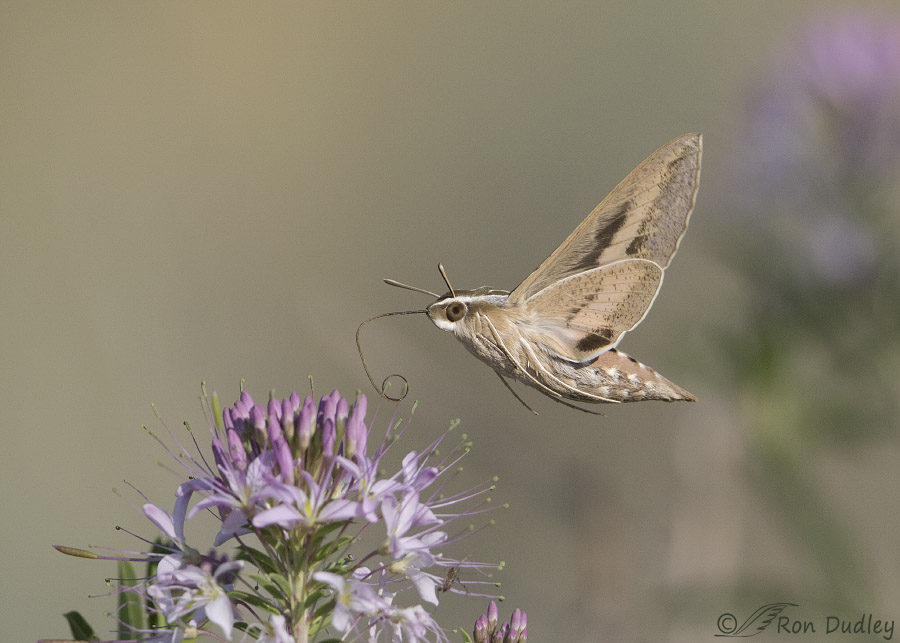
1/8000, f/5.6, ISO 800, Canon 7D Mark II, Canon EF 500mm f/4L IS II USM + EF 1.4 III Extender
While I was photographing hummingbirds two days ago at the patch of Rocky Mountain Bee Plant I had several opportunities with sphinx moths feeding on the nectar of the same flowers. I wasn’t able to get quite as close to them as I’d have preferred (these images have been cropped significantly) but I think I still got some interesting photos. I believe these are the White-lined Sphinx Moth, one of several varieties of sphinx moth. They’re also commonly called “hummingbird moths” because their feeding and flight habits are very similar to those of hummers.
Like hummingbirds they hover over flowers feeding on nectar but instead of using long bills to get at it they use their very long proboscis. Here we see it still partially coiled up just before it was fully extended into the flower.
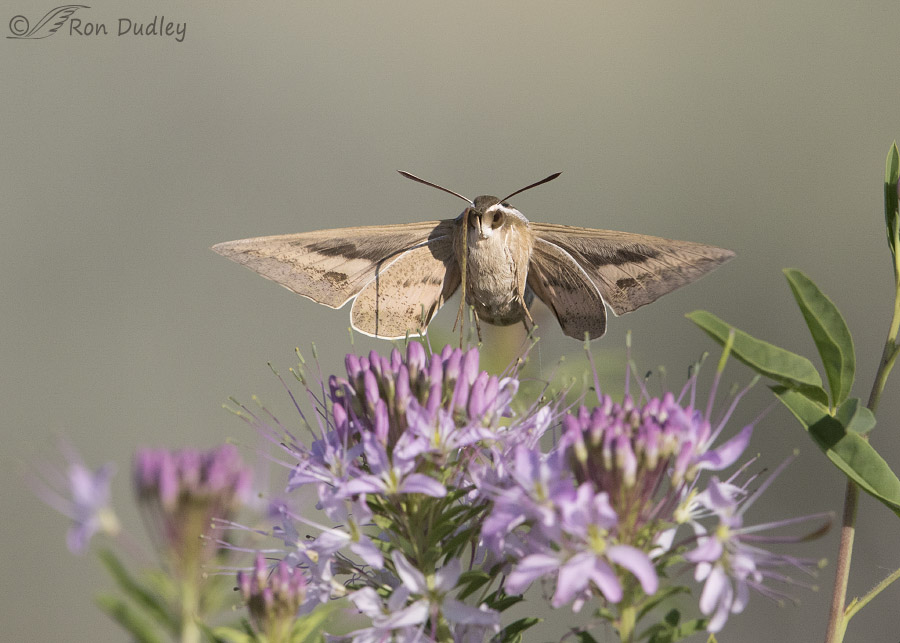
1/5000, f/6.3, ISO 800, Canon 7D Mark II, Canon EF 500mm f/4L IS II USM + EF 1.4 III Extender
A front view gives us a different perspective on their feeding behavior as one hovers over a flower cluster.
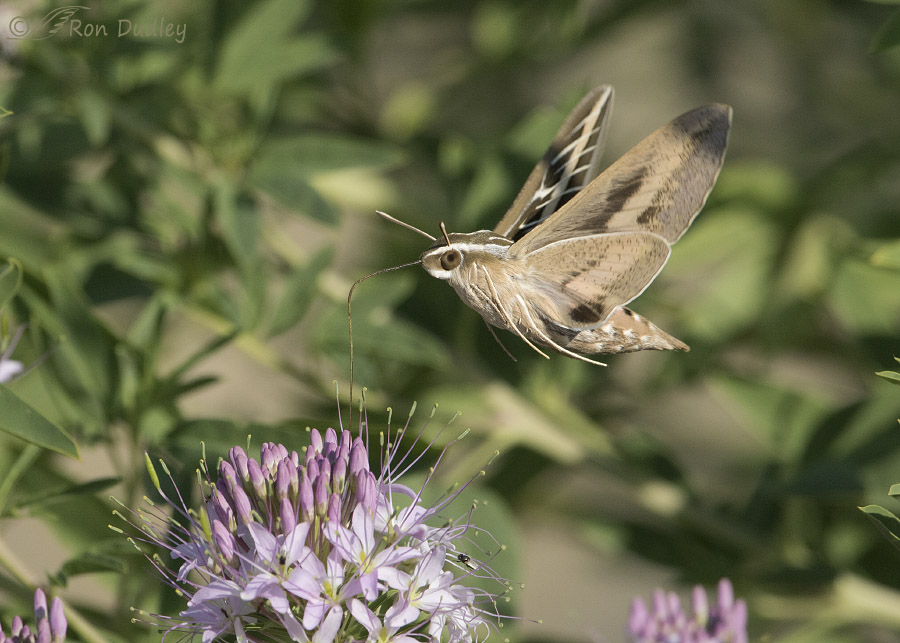
1/3200, f/6.3, ISO 800, Canon 7D Mark II, Canon EF 500mm f/4L IS II USM + EF 1.4 III Extender
When it’s fully extended the proboscis is very long. Here we see only part of it – the rest disappears into the depths of a long flower. I’ve seen some apparently reliable references saying that their proboscis can be in excess of 10″ long.
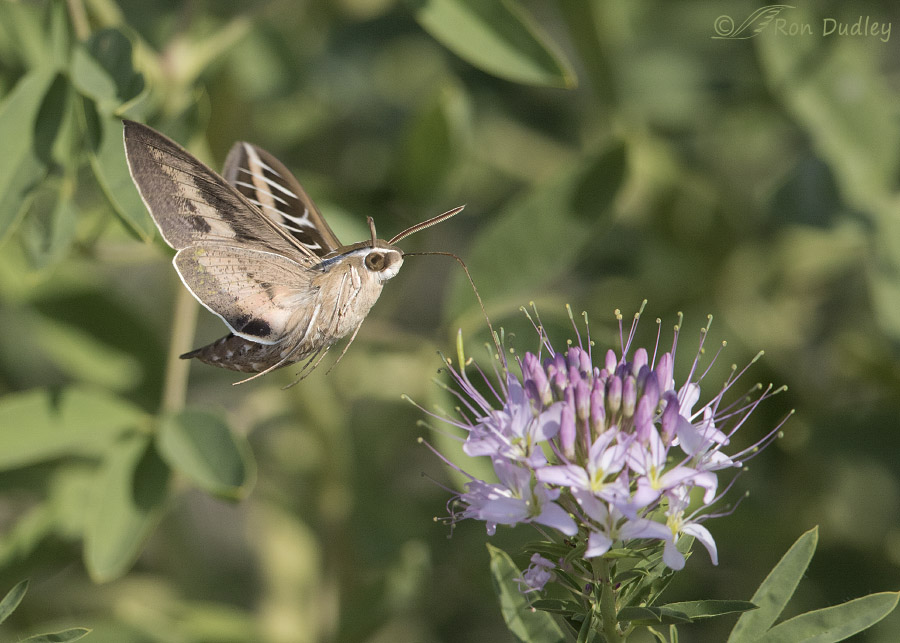 1/4000, f/5.6, ISO 800, Canon 7D Mark II, Canon EF 500mm f/4L IS II USM + EF 1.4 III Extender
1/4000, f/5.6, ISO 800, Canon 7D Mark II, Canon EF 500mm f/4L IS II USM + EF 1.4 III Extender
In this shot I enjoy seeing the bristles on the left antenna (if I squint a little…).
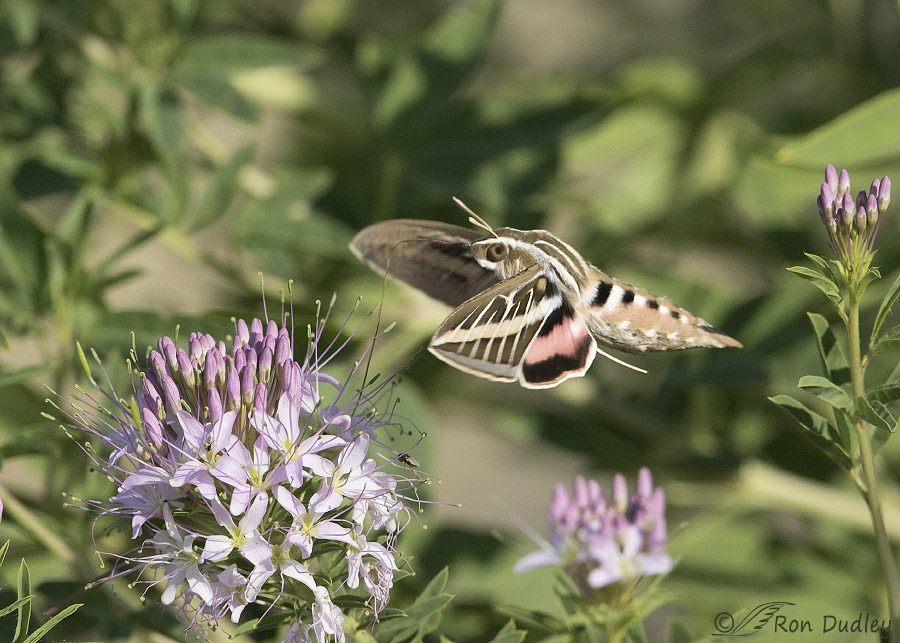
1/3200, f/6.3, ISO 800, Canon 7D Mark II, Canon EF 500mm f/4L IS II USM + EF 1.4 III Extender
This species is actually quite colorful but much of that color is on the dorsal surface of their hindwings so you have to get just the right angle and wing position to see it well.
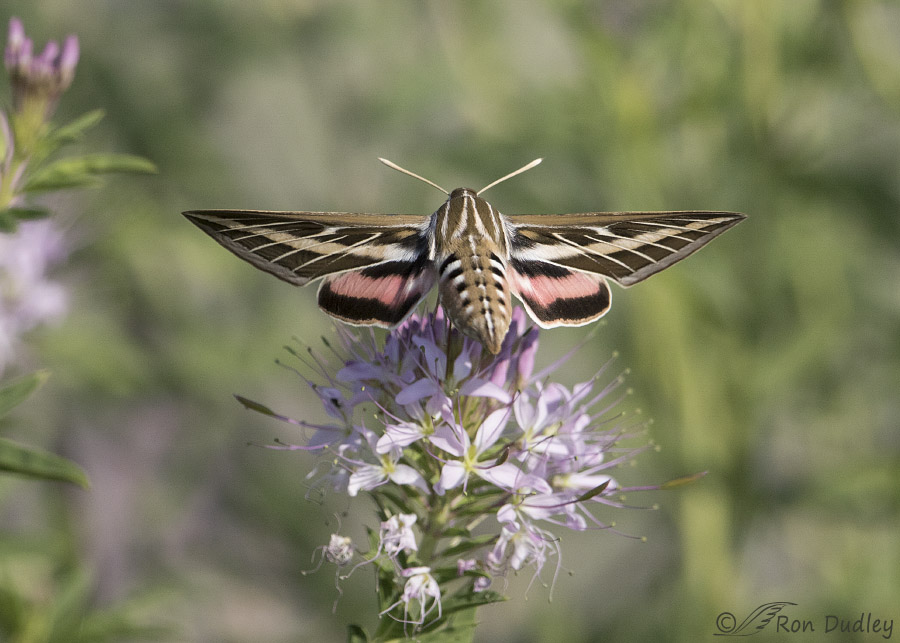
1/5000, f/5.6, ISO 800, Canon 7D Mark II, Canon EF 500mm f/4L IS II USM + EF 1.4 III Extender
Too bad the best look at that color is from behind…
The larval caterpillars of the White-lined Sphinx Moth are quite large and served a useful purpose for some Native Americans for centuries. I always enjoy learning these little tidbits and I hope some of my readers do too (taken from the University of Wisconsin Master Gardener Program):
- “An interesting side note is that the caterpillars were once used as a food source by Native Americans. When abundant, the Cahuilla and Tohono O’odham collected nearly mature caterpillars feeding on sand verbena and other plants in the Southern California and Sonoran deserts. They pulled off the head and jerked out the guts, then placed the larva in a bag or basket. In the evening the insects were roasted, skewered on a stem, for a feast. Leftover caterpillars were dried over hot sand from a fire, then stored either whole or ground up.”
Caterpillar crispies with your morning coffee anyone?
Ron


Amazing images of excellence, Ron.Saw my first Sphinx moth here in Edmonton hanging on the screen this summer.Thought it was dead til I touched it with a twig and it moved! Eat it? No-o-o-o.
Excellent series, Ron. I really love Sphinx Moths. I have seen them in various parts of Canada and in Europe (Switzerland and Germany.) In our area we have the Clear Wing and the ones in Europe look about the same but are very small. Beautiful creatures.
Lovely photos once again! They’ve just inspired an internet foray into the life and habits of the Sphinx Moth!
Good. They’re very interesting critters, Joanne!
Having learnt about Sphinx moths on the blogosphere (probably here) I am always glad to see them. They are much more attractive than our Bogong moths which swarm my city each year. They were also relished by our indigenous people and supposdedly taste like charred pork fat . I think I will pass on that one.
Sounds like your mountain pygmy possums think they taste pretty good, EC – maybe you should rethink this one… 🙂
That caterpillar eating thing goes in the same department of how vultures keep the bacteria on their legs under control by peeing on them. Not my choice of how to handle things, but to each his/her own!
But that’s one beautiful insect!! AMAZING about the proboscis, both extended and coiled!
I agree with your departmentalization, Laura! Thanks.
Ron, what a fascinating series both in terms of beautiful photos and lots to learn. I googled proboscis to learn more about it and interestingly enough it was also defined as the trunk of an elephant. In the photo of the butterfly they used as an example, the proboscis was curled up under the ‘chin’. I wonder if the sphinx moths do the same.
Thanks so much for this series. It made my day!
“I wonder if the sphinx moths do the same.”
They certainly do, Alice. Thank you.
These are wonderful pictures of such an interesting creature. i love watching thrm, but then, I’ve given up on growing tomatoes…as I understand it, their larvae are the tomato hornworm…we had cleome and butterfly bushes that they loved…unfortunately, the bushes didn’t survive a harsh Maine winter…
I’ve eaten chocolate covered bees, catapillars and ants…given to me many years ago by a smarty pants babysitter..I didn’t realize what I was eating until she told me…I remember they were little squares and came wrapped in gold and silver foil…..and that the chocolate wasn’t very good…one of the legs of the one with the ants got stuck between my teeth!
Patty, I planted Rocky Mountain Bee Plant (ordered the seeds) in my garden this spring with the specific intention of attracting moths and hummers. Like a dummy I tilled them up accidentally…
Patty, tomato hornworm turns into a totally different moth. It is darker and much larger, with black and gray mottled pattern on the upper wings and black/white on the lower wings, with yellow spots on the abdomen.
Beautiful photos as always. I have a lot of sphinx moths in my yard but they are only out when it is too dark to photograph their fast movement. The women who lives in my basement apartment plants bee plant in my yard every year. I have not noticed the hummers liking it but it could be due to my 6 feeders spaced around the yard too.
I’ve read that they’re largely nocturnal, April, so I’m surprised that these guys never show up at the patch until over an hour after sunrise.
Boy, you got a. Lot of responses on this fantastic series! you photo capture are so perfect and I’m glad you let us know your camera settings!
I marveled at your tack photos and I love the moth that so many of my neighbors call a Hummbinsird Moth.
Linda, believe me I have many more soft shots of these guys than I do sharp ones. Or at least I did – I just now finished ALL of my culling!
Yuck! I’m afraid I can’t fathom eating caterpillars. To this day people like the Thais eat grubs (caterpillars). The moth is definitely a White-lined Sphinx, a species I’ve been familiar with since I was a teenager. I very much enjoy seeing them to this day.
Thanks for the ID confirmation, Susan. I was pretty sure but just short of positive.
Phenomenal shots, Ron! I totally see the detail on those antennae. Just gorgeous! 🙂
I generally think of caterpillars as a bit on the furry side — not sure if caterpillar crispies would tickle going down. *shudder*
We could roast them like the Indians did, Marty. That would burn off those pesky bristles…
Yeah, but there’s still the issue of the caterpillar. 😉
*giggles… I don’t think I need the extra Crispies this morning…
but DO ENJOY your pictures. Last year I had several of the Spinx moths on my Hostas’ Flowers & so enjoyed their visit, maybe again?
Once again… thank you for sharing your talents/views with us all.
I just finished my eggs, ham and toast, CaJ – otherwise I’d partake. Not…
What a wonderful series ! I think white-lined sphinx moths are beautiful and very interesting–and yours this AM are the best images of them I’ve seen……..so thanks, I’d rather look at ’em
than eat ’em……….although they’re BIG and would be a good, ready resource !
“I’d rather look at ’em than eat ’em”
Me too, Kris – it isn’t even a horse race!
Great capture of the Sphinx Moth, Ron. They are interesting creatures for sure. Not THAT hungry – yet 🙂 Belt creek is not running at the moment – no more watering for us and, unless things change, in about 10 days we’ll be hauling drinking water as old shall well is dependent on it 🙁 Many birds bunching up and on their way S stopping for a drink and whatever grub they can come up with.
Wow, sounds like things are dry up there too, Judy. I’ve been seeing photos of a bad fire near Missoula. Hope you’re not getting smoke…
We are getting the smoke – VERY bad the past couple of days and it held the heat in last night only dropping to 62 – finally – at about 4 this morning:( Main fires around here have been short lived and, mostly machinery caused.
When I was a kid we had a bad field fire on a farm near ours outside of Cut Bank. A combine we’d sold to that farmer burned up in the fire. Very scary…
Yep – those field fires don’t need much of a breeze to “fly”
Fabulous Photos, Ron!! You are amazing and the Sphinx Moth is beautiful. The last 2 photos are especially incredible. Thank you for your patience and for sharing your outstanding talents with us.
These moths in flight certainly challenged any talents I may have, Melanie. They’re significantly smaller than a hummingbird and locking focus on them when they’re so close to a flower and moving fast wasn’t easy. My delete bin needs emptying…!
Awesome series Ron!
Charlotte
Thanks, Charlotte.
Good Morning Ron,
Wonderful pictures and a very interesting story.
Good morning to you too, Len. Thanks.
Ron, these images are spectacular!! Best I’ve seen of these critters–which are indeed, really fun to see 😉 We’ve not seen any this year, so I am especially enjoying this post and story–thank you!
Thanks very much, Christine. Seeing them was a special treat for me too!
I am having daily visits from these beauties on my butterfly bushes. Love to watch them. Great photos, thanks so much.
You’re lucky, Sarah. I have to be fortunate to even find them – yesterday there were no moths on the patch like there was the day before.
Absolutely beautiful shots Ron! I certainly envy you having this Sphinx Moth around.
I’ll pass on the crisps! However, if I was brought up on them maybe not so bad!
I think I’ll pass on them this time too, Dick. But if we got hungry enough…..